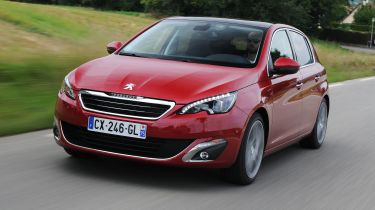Peugeot 308 2013 review
We test the new Peugeot 308, a rival for the likes of the SEAT Leon and Volkswagen Golf

The new Peugeot 308 might not get a new name, but it does takes a giant leap towards becoming a desirable family hatch. Yet while the practical boot and efficient engine line-up both impress, some old niggles still remain. For now, it lacks the high quality and dynamic polish that are required to beat the class best in this extremely hard fought segment, but it’s a worthy attempt. We suspect the clean diesel models will make more sense.
Can the all-new Peugeot 308 carry on the momentum created by the success of the 208 and 2008, when faced with talented rivals such as the new SEAT Leon and Volkswagen Golf?
It certainly arrives armed and ready for a fight, thanks to a new lighter and stiffer modular chassis platform, radical new interior design and an impressive array of on-board technology.
From the outside though the 308 is a little underwhelming. The exterior does show hints of inspiration from both the SR-1 and Onyx concept cars but the design is quite derivative, and despite glitzy details like the 18-inch wheels and full LED headlamps fitted to our top-spec test model, it lacks the visual flair of its premium opposition.
This is the first Peugeot to use the shared ‘EMP2’ platform that also underpins the new Citroen C4 Picasso, and the result is a car that is now lower, wider and (in some cases) 140kgs lighter than its predecessor. This drastic weight saving offers big benefits when it comes to fuel economy, with every diesel model in the line-up now emitting 100g/km of CO2 or less and returning well over 70mpg.
Used - available now
From early next year a ‘BlueHDi’ model with an incredible headline figure of 91mpg will set new class standards for efficiency, but here we are testing the flagship petrol version – with the familiar 153bhp 1.6-litre turbocharged engine sourced from BMW.
Push the classy silver starter button on the centre console, and it fires smoothly into life, and with a healthy 240Nm of torque available from as low as 1,400rpm it pulls strongly through the first few ratios of the long-throw six-speed manual gearbox.
Performance is brisk too, with 0-62mph achieved in 8.4 seconds, but the soft suspension setup means you rarely feel the need to extract the maximum from the engine. There is a fair amount of body roll when cornering too, and even though our test route was fairly smooth bigger bumps do send a shudder through the seats – which threatens to spoil ride comfort and cruising refinement. However the diesel models that we tried on smaller wheels did offer a more cossetting low-speed ride.
The new ‘i-Cockpit’ interior design, which features a small sporty steering wheel and a set of pod-like instruments mounted high on the dash, is similar to the cabin in the 208. But in the 308 the interior is dominated by an iPad style 9.7-inch touchscreen. Tilted towards the driver, it controls virtually all the major functions, including driving apps and a hard drive for storing music. It looks great and translates into a refreshingly button free centre console - something rivals like the Ford Focus would benefit from.
However it can be slow to react, and the absence of a simple ‘back’ button can lead to the odd moment of frustration while navigating the various sub-menus. Removing the climate controls also means you often find yourself flicking back and forth between the different screens.
Space in the back is impressive though, with the 308 boasting an enormous 435 litres of space with the seats in place (with an extra 35 litres also hidden beneath the boot floor) but rear passenger space does suffer as a result, with both head and legroom in short supply even for passengers of average height, although this problem was exacerbated by panoramic glass roof of our test car.











